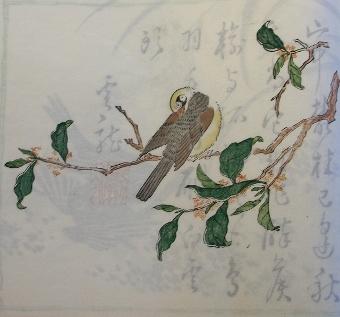
Ten Bamboo Studio Collection of Calligraphy and Painting
One of the very first examples of multi-color wood block printing, the Ten Bamboo Studio Collection of Calligraphy and Painting, was first published in China by Hu Zhengyan in the early 17th century, c. 1633. Named after the bamboo growing in front of his studio, these editions are masterpieces of color woodblock printing, and consist of eight subjects, bound as books, pairing each image with a matching poem by a master calligrapher.
The volumes are divided by the subject matter: instructions, orchids, bamboo, plums, round fans, stones, fruit, birds & flowers. The poems were chosen from a variety of old masters, and paired with water color sketches. Hu Zhengyan assembled a team of seven other artists to assist him in creating the wood blocks and calligraphy for these editions.
These volumes employed an innovative printing technique called tou-pan, that allowed for subtle, multi-color printing, and replicated the look and feel of delicate watercolor paintings. This enabled these volumes to serve as painting manual, predating the famous Mustard Seed Garden Manual of the late 16th century by several decades.
Tou-pan printing employed different sizes of blocks are designed according to the colors and shades of the painting that needs to be printed. The painting was traced onto sheets of transparent paper and the sheets are covered reversely on the blocks so that the mirror images of the designs can be carved out. Following the prescribed order, the blocks are printed onto a sheet of paper. Some blocks create overlapped areas and as a result, different shades of colors will appear and the final product will look almost exactly the same as the original painting.
Shi zhu zhai shu hua ce by Hu Zhengyan [no publication date, call #726.4 H86s] from the Sherman Art Library Special Collection will be on display in the Sherman Art Library reference room.